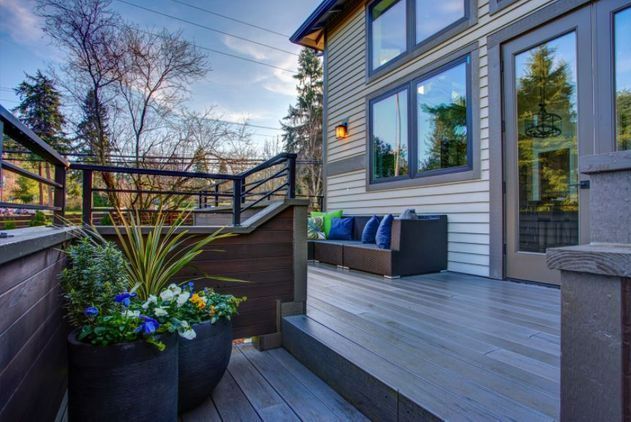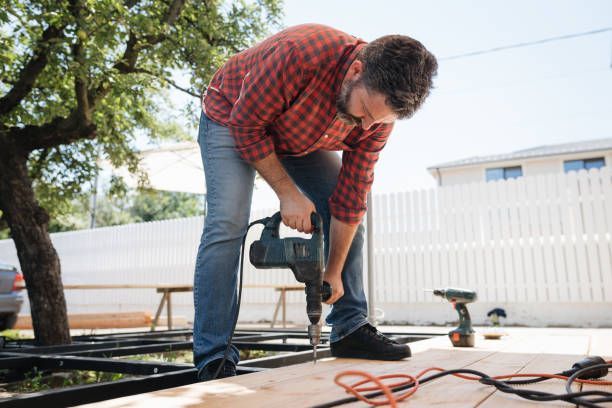Maple Ridge Fence & Deck
Local Deck Installers' Tips on Building Climate-Resilient Outdoor Space
Outdoor spaces are integral to our homes, serving as spaces for relaxation, entertainment, and family gatherings. However, the impact of climate on these spaces cannot be overlooked. Unpredictable weather patterns, extreme temperatures, and seasonal changes can wreak havoc on outdoor installations, making it essential to design and build climate-resilient outdoor spaces.
The
local deck installers
will provide important tips on establishing climate-resilient outdoor spaces.

The Importance of Climate Resilience in Outdoor Spaces
Climate resilience in outdoor spaces goes beyond aesthetics. It's about creating environments that can withstand the challenges the local climate poses, ensuring longevity and minimizing maintenance costs. From hot to cold seasons, a climate-resilient outdoor space should be equipped to handle various weather conditions without compromising functionality or style.
Factors Influencing Climate-Resilient Outdoor Design
Several factors impact the design and construction of outdoor spaces to make them resilient to local climate variations. These include:
Local Climate Conditions
- Identify the typical weather patterns in your area, including temperature ranges, precipitation levels, and extreme conditions.
- Consider seasonal variations and how they might impact the use and maintenance of your outdoor space.
Topography and Landscape
- Analyze the natural features of your surroundings, such as wind patterns, sunlight exposure, and potential drainage issues.
- Use the landscape to your advantage, creating sheltered areas and optimizing natural elements for comfort.
Material Selection
Choose deck materials that can resist the local climate without deteriorating quickly. Consider the ecological impact of materials and opt for sustainable choices when possible.
| Outdoor Space Component | Recommended Materials |
|---|---|
| Decking | Tropical hardwoods, composite |
| Furniture | Powder-coated aluminum, teak |
| Cabinets | Marine-grade polymer, stainless steel |
| Roofing | Metal, UV-resistant polycarbonate |
Weather-Resistant Materials for Outdoor Decking
| Decking Material | Key Features |
|---|---|
| Tropical Hardwoods | Naturally resistant, durable, and exotic |
| Composite | Low maintenance, resistant to rot and insects |
| PVC | Lightweight, resistant to moisture and fading |
Incorporating Features that Withstand Local Weather Variations
Beyond material selection, incorporating features that withstand local weather variations is essential for climate resilience. Consider the following tips:
- Install pergolas, awnings, or umbrellas to provide shade and protect against intense sunlight.
- Use fences, trellises, or strategically placed plants to create windbreaks and shield your outdoor space from strong winds.
- Ensure efficient drainage to prevent water accumulation, especially in areas prone to heavy rainfall.
Tips for Maintaining Climate-Resilient Outdoor Spaces
Building a climate-resilient outdoor space is the first step; regular maintenance is crucial to ensure longevity. Here are some tips from local deck installers:
- Periodically inspect all outdoor components for wear and tear. Address any issues promptly to prevent further damage.
- Regularly clean surfaces, furniture, and accessories to prevent the buildup of mold, mildew, or stains.
- Apply appropriate sealants and coatings to protect materials from UV rays, moisture, etc.
- Adjust your maintenance routine based on the seasons. For example, prepare your outdoor space for winter by storing certain items and protecting others from the harsh weather.
Partner with Qualified Local Deck Installers for Your Next Deck Project
Ready to create a sturdy outdoor space? Teaming with skilled local deck installers is the key to making your vision a reality. Deck specialists at Maple Ridge Fence and Deck have the experience to tackle the challenges unique to your local climate.
When you trust your deck project to us, we ensure the use of strong materials and construction methods. Plus, you get valuable insights that can greatly impact the durability and look of your outdoor area. Partner with us for your next deck project. Contact us for a free consultation.

FAQs
-
What Is the Best Deck for Hot Climates?
Choose composite decking as it needs less upkeep and can resist heat damage. Composite decking is created out of plastic and wood, making it sturdy and resistant to cracking or warping from intense sunlight. Unlike traditional wooden decks, composite decking doesn't require painting or staining, reducing the need for ongoing maintenance.
Look for UV protection and slip-resistant finishes when selecting composite decking to enhance durability and safety. Some composite decks have reflective pigments that deflect light, keeping the boards cooler in hot weather. Pick lighter-colored composite decking to avoid excessive heat absorption during direct sunlight, ensuring a more comfortable surface.
By choosing composite decking with these considerations, homeowners can make a smart investment that withstands extreme temperatures for years.
-
How To Select Decking for Cold Climates?
- Choose decking materials for outdoor use to ensure they can withstand the cold weather.
- Treat wood or composite boards to resist rot and weather damage. Plastic lumber is also a good option due to its higher resistance.
- If possible, go for decking made of polypropylene for increased durability, especially in extremely cold temperatures.
- Pick decking with grooves on the underside for better water drainage during snowy periods.
- Consider materials with features like textured surfaces for better traction or metal grates to prevent snow buildup.
- Rubberized coatings provide extra protection against slipping on icy surfaces, enhancing safety.
- Consider specific characteristics of materials to achieve satisfactory results, regardless of challenging weather conditions.
-
How To Protect Decks From Extreme Temperature Changes
- In places with extreme temperature changes, like cold climates, pick materials made for those conditions. Composite decking or fiberglass reinforced plastic (FRP) is better than traditional wood because they don't warp or crack in harsh weather.
- Look for materials with UV protection to prevent them from fading in the sun. Also, choose products with slip resistance to reduce the risk of slipping on icy surfaces during winter.
- Check your deck for chances of wear and tear, like loose parts or cracks. This helps you fix any problems quickly.
- In winter, be aware of snow on your deck. Also, if possible, add a roof for extra protection from heavy rain and frosty mornings.
SERVICE AREAS
Maple Ridge, Pitt Meadows, Mission, Langley, Abbotsford, Coquitlam, Chilliwack, Delta, Surrey, Poco, Burnaby, Vancouver, Richmond, North Vancouver, Tsawwassen
Our Services
All Rights Reserved | Maple Ridge Fence & Deck
